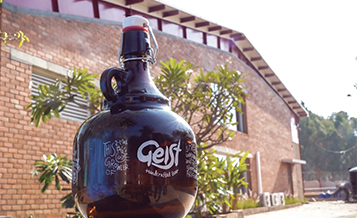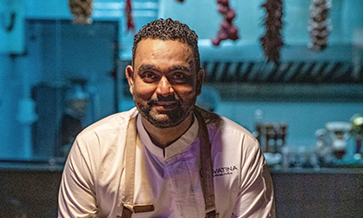The most popular craft beer in America for more than 15 years in terms of barrels produced and revenue earned has been the India Pale Ale (IPA). At the Great American Beer Festival, IPA was the most competitive category for more than a decade.
Even a poll set out by the American Home Brewers’ Association found Russian River’s Pliny the Elder – yes, an IPA – as the most popular beer in America for 5 years in a row. It seemed that any brewer who crafted a beer with an alcohol level above 6% and a bitterness level above 60 IBU (International Bittering Units) could almost guarantee that it would be a big success.
There are West Coast IPA’s, crisp and clear, filtered and/or fined to create an aggressively hopped ale with little malt backbone. Cascadian Dark Ales are nearly as black as stouts, but without the chewy maltiness of stouts and all the bitterness and aroma of an IPA. They have become a crafty way to mimic the IPA in the dark beer lover’s category.
Red IPAs, or Imperial Red Ales, were the answer to those who loved the caramel flavors and aromas of malt as well as a skunky hop bomb of a beer. Even White IPAs, a coriander and orange peel, Belgian style Witbier was co-opted into the IPA category with some versions being more than 8% alcohol and hopped to the brim with citrusy hops such as Columbus and Citra.
Belgian brewers themselves created Belgian IPAs brewed with their own special yeast strains for a funky take on ester driven beers. The category of session IPA was even created for beers under 5.5% alcohol. Really, this was just a hoppy pale ale, but brewers needed yet another IPA style to develop for their customers.
New England IPA
Wherever you went, there were beer styles normally reserved for non-IPA beers being overly hopped and absorbed into the IPA category. This palate of hop madness was the norm for years, until a few brewers from the East Coast decided to make beers in an almost inconceivable way.
The basis for the New England IPA (NEIPA) was really formed by a few brewers in Vermont. The Alchemist and Hill Farmstead breweries started to take the now classic West Coast IPA and make it even hoppier, even more flavorful, and even more aromatic with new hop varieties and twice the amount of hops.
A classically trained brewer would tell you that hop aroma, flavor and bitterness needed to be isomerized into the wort and subsequent beer through boiling and whirlpool additions. In this fashion, the beer could be finished and stabilized the way all beer was, through filtration to create a visibly clear beer.
Well, some innovative brewers thought that the volatile aromas of the hop flower were being lost in this process and found a way to maintain a perpetual haze through yeast selection and adjunct brewing to keep hop oils from dry hopping suspended through the beer in a revolutionary method of massively unfiltered beer.
The resulting beer has very little initial bitterness and outrageous amounts of flavor and aroma that created a perception of an IPA with the smooth mouth feel of a glass of fresh squeezed orange juice.
Hype over cans
Dry hopping in these beers went from a powerful 2 pounds per barrel to 5 pounds per barrel on the first dry hop addition, and even another 2 to 4 pounds on the second dry hop addition. It was truly madness!
Craft beer lovers wanted to “burp hops”. Truly, the beers that coated the mouth most aggressively with fresh hop oils were the winners in this segment.
Heady Topper, the beer from The Alchemist, was packaged in a can. At first, the company recommended that customers “drink right from the can” and not pour it into a glass.
Even those brewers would admit they were taking the IPA way too far and residual flakes of hop flowers would be seen floating in the beer if you actually poured Heady Topper into a glass.
The hype was real and it was gaining traction. People were lining up to buy these beers fresh from the brewery the day they were released. The fresher and hazier, the better!
Trillium Brewing from Massachusetts, sells nearly 30,000 barrels of beer direct to customers at their brewery each year: all NEIPAs. The rush to make the hoppiest, freshest, haziest beer around is now the most popular IPA in the USA.
In March of 2018, the Brewers Association recognized NEIPAs as a new category and, for the first time in nearly 18 years, became the most popular and competitive category at the Great American Beer Festival. The New IPA is here to stay!
Craft & creativity
Today, NEIPAs are the driving force in craft beer creativity. The soft mouth feel from a malt bill of mostly oats and wheat create a platform that supports fruit additions, lactose and vanilla additions, and even citric acid to create a truly juicy experience.
Milkshake IPAs have an abundance of vanilla and lactose to mimic the childhood beverage of a fresh whipped milkshake topped off with the latest Galaxy, Vic Secret, Nelson Sauvign or Mosaic hop. Fruit purée of passion fruit, guava and pineapple are added to create an even fruitier experience reminiscent more of a blended tropical cocktail than a classic beer.
Blends of slight caramel malts can sometimes make a hazy beer that really looks just like a glass of fresh squeezed orange juice and then dry hopped to the gills with citra hops. If one were to close their eyes and sip a well-crafted NEIPA, they may be fooled into thinking they are really drinking juice.
These New IPAs are meant to be consumed fresh. The experience changes as these beers are allowed to rest in their cans. The trend amongst NEIPA brewers is to release new styles on a weekly basis for the latest trends in hop blending and the next great combination of adjuncts, fruit flavors, subtle spices and even more.
I don’t think that this style is going away anytime soon as the possibilities seem endless and the demand is really only beginning to grow. The thrill for a brewer is that there really is no correct way of making this beer style.
Only three basic rules really apply: little to no bitterness from kettle addition hops, the use of adjuncts such as oats and wheat to create a perpetual haze, and more dry hops than ever before.
The NEIPA is a hop lovers’ playground. If you love hops so much that you would want to savor a mouthful of aroma and flavor for hours after your last sip, then find the freshest version to come on tap and experience IPA like never before.














